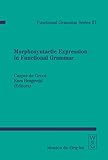Morphosyntactic Expression in Functional Grammar / ed. by Casper de Groot, Kees Hengeveld.
Material type: TextSeries: Functional Grammar Series [FGS] ; 27Publisher: Berlin ; Boston : De Gruyter Mouton, [2012]Copyright date: ©2005Description: 1 online resource (534 p.)Content type:
TextSeries: Functional Grammar Series [FGS] ; 27Publisher: Berlin ; Boston : De Gruyter Mouton, [2012]Copyright date: ©2005Description: 1 online resource (534 p.)Content type: - 9783110183658
- 9783110920833
- 415/.9 22
- P290 ǂb M67 2005eb
- online - DeGruyter
- Issued also in print.
| Item type | Current library | Call number | URL | Status | Notes | Barcode | |
|---|---|---|---|---|---|---|---|
 eBook
eBook
|
Biblioteca "Angelicum" Pont. Univ. S.Tommaso d'Aquino Nuvola online | online - DeGruyter (Browse shelf(Opens below)) | Online access | Not for loan (Accesso limitato) | Accesso per gli utenti autorizzati / Access for authorized users | (dgr)9783110920833 |
i-iv -- Preface -- Contents -- Agreement: More arguments for the dynamic expression model -- Constituent ordering in the expression component of Functional Grammar -- Dynamic expression in Functional Discourse Grammar -- Noun incorporation in Functional Discourse Grammar -- Morphosyntactic templates -- A crosslinguistic study of ‘locative inversion’: Evidence for the Functional Discourse Grammar model -- The agreement cross-reference continuum: Person marking in FG -- The explanatory power of typological hierarchies: Developmental perspectives on non-verbal predication -- Non-verbal predicability and copula support rule in Spanish Sign Language -- A new view on the semantics and pragmatics of operators of aspect, tense and quantification -- Exclamation: Sentence type, illocution or modality? -- Close appositions -- Inversion and the absence of grammatical relations in Plains Cree -- Direction diathesis and obviation in Functional Grammar: The case of the inverse in Mapudungun, an indigenous language of south central Chile -- Unexpected insertion or omission of an absolutive marker as an icon of a surprising turn of events in discourse -- Pronominal expression rule ordering in Danish and the question of a discourse grammar -- Index of names -- Index of languages -- Index of subjects
restricted access online access with authorization star
http://purl.org/coar/access_right/c_16ec
Morphological and syntactic issues have received relatively little attention in Functional Grammar, due to the fact that this grammatical model, given its functional orientation, was primarily concerned with developing its pragmatic and semantic components. Now that these have been solidly developed, this book turns to the further development of the syntactic and morphological components of the model. Two recent developments receive pride of place: Bakker's Dynamic Expression Model and Hengeveld and Mackenzie's Functional Discourse Grammar. The first model aims at accounting for the complex interactions that one finds in many languages between the sets of expression rules that have to account for form on the one hand and those that establish order on the other. The second model takes a further step by considering morphosyntactic and phonological representations to be part of the underlying structure of the grammar rather than as the output of that grammar, contrary to the original assumptions in FG. The book accordingly contains synopses of these two proposals as well as applications of these to a variety of linguistic phenomena. Further articles provide detailed analyses of a range of semantic and pragmatic categories and their morphosyntactic expression in a wide variety of languages. The articles in this book contain data on some 60 different languages, including focused articles on phenomena in Arabic, Danish, English, Lengua de Señas Española, Mapudungun, Plains Cree, and Tanggu. In all, the contributions to this volume show that the issue of morphosyntactic expression in Functional Grammar is very much alive and moving into promising new directions, while at the same time contributing to a better understanding of a large number of morphosyntactic phenomena in a wide variety of languages.
Issued also in print.
Mode of access: Internet via World Wide Web.
In English.
Description based on online resource; title from PDF title page (publisher's Web site, viewed 28. Feb 2023)


